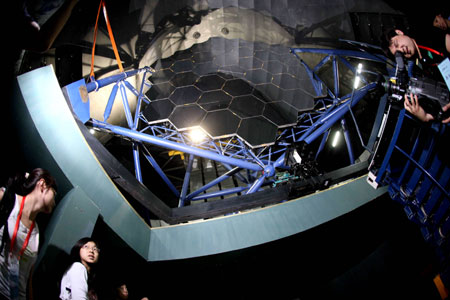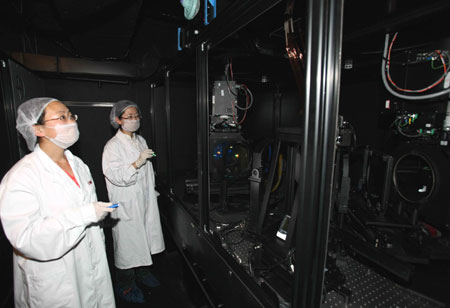China produces the largest telescope
China is embarking on its own ground-based optical telescope to help astronomers actively observe the sky for another five to six years.
The Chinese government intends to spend up to 235 million yuan (about US $ 34 million) to help scientists and technical experts successfully implement this daring project. The project has an abbreviated name in English that is LAMOST, meaning, the telescope observing the sky.

The visitors are watching a part of the converging mirror.
Optical expert Cui Xiangqun, head of the research team, said the focus of the project is to design and manufacture ground-based optical telescopes with 24 hexagonal convergence mirrors. Cui Xiangqun has worked for many years at the Nanjing Astronomical Optical Technology Institute, under the Chinese Academy.
Show Cui Xiangqun and his team make these mirrors. Each mirror piece has a distance between two symmetrical peaks of 1.1m in length. This size, helps to minimize errors in images collected. When active, the light coming from the stars in the sky will reflect to a large sphere mirror, made of 37 hexagonal mirrors of the same size as the converging mirror group.

In only 5 to 6 years, China's largest telescope in the world will come into operation.
With reflectors with a width of up to 3.6m and a spherical mirror with an expansion of up to 4.9m, together with the mirror focal surface containing 4,000 optical fibers . Chinese astronomers will determine exactly the spectrum of about 2.5 million stars, 2.5 million galaxies, 1.5 million galaxy clusters . This could help China become one of the countries with relatively complete records about celestial bodies in the universe.
Historically, spectroscopy is the key to "reading" astronomers and capturing information about the constituents, density, magnetic fields and atmospheres of celestial bodies. This is also the way the scientific community seeks celestial bodies with appropriate conditions for life. Currently, scientists in the world only have information about 10,000 celestial bodies.

Under the plan, the LAMOST project will place a telescope at the National Observatory in Hubei Province, north of China.
Over the years, Chinese media have recorded some of the country's achievements in manufacturing satellites and boosters, two important technologies, which are the basis for space exploration and exploration. The investment in the construction of modern astronomical devices again confirms the country's ambition for the sky.
Before China's astronomical project, the United States also carried out a similar project called SDSS, building an observation station in New Mexico state. However, SDSS telescope only has an opening of 2.5m.
- China's largest operator, the world's largest telescope
- China builds the world's largest telescope
- China relocated more than 9,000 people to hunt people out of space
- The world's largest telescope performs historical mission
- China announced plans to 'hunt' aliens with the largest telescope
- Prepare to install the world's largest telescope
- China hunts aliens with giant telescopes
- China installs the largest telescope in Antarctica
- China revealed Asia's largest telescope
- Astronomy is as big as 30 football fields in China
- China built a giant solar telescope
- The world's largest alien hunting telescope was born
 Van Allen's belt and evidence that the Apollo 11 mission to the Moon was myth
Van Allen's belt and evidence that the Apollo 11 mission to the Moon was myth The levels of civilization in the universe (Kardashev scale)
The levels of civilization in the universe (Kardashev scale) Today Mars, the sun and the Earth are aligned
Today Mars, the sun and the Earth are aligned The Amazon owner announced a secret plan to build a space base for thousands of people
The Amazon owner announced a secret plan to build a space base for thousands of people Unprecedented History: 6 Countries Create 'Magic Eye' 50 Million Times More Powerful Than Human Eye
Unprecedented History: 6 Countries Create 'Magic Eye' 50 Million Times More Powerful Than Human Eye  What color is the mirror? 99% of people get it wrong!
What color is the mirror? 99% of people get it wrong!  Meteor causes 'unrepairable' dent in James Webb glasses
Meteor causes 'unrepairable' dent in James Webb glasses  India installs world's first liquid mirror telescope
India installs world's first liquid mirror telescope  Successfully fabricated a diamond mirror that can withstand the power of a 10kW . laser
Successfully fabricated a diamond mirror that can withstand the power of a 10kW . laser  Why do we find ourselves most beautiful in the mirror?
Why do we find ourselves most beautiful in the mirror? 